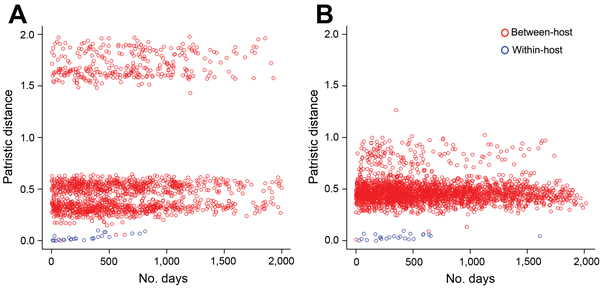Volume 21, Number 5—May 2015
Research
Transmission of Hepatitis C Virus among Prisoners, Australia, 2005–2012
Figure 3

Figure 3. Analysis of pairwise patristic distances between hepatitis C virus sequences from the same participant (within-participant) sampled over time, and from between participants also sampled over time, among prisoners in New South Wales, Australia, 2005–2012. Analysis shows pairwise patristic distances as a function of the time interval between 2 sampling time points: within-participants (blue circles) and between-participants (red circles) for genotypes 1 (A) and 3 (B). A) Blue circles represent data from 35 participants, for a total of 57 sequences; B) blue circles represent data from 49 participants, for a total of 73 sequences.
1Additional HITS-p investigators are listed at the end of this article.
Page created: April 20, 2015
Page updated: April 20, 2015
Page reviewed: April 20, 2015
The conclusions, findings, and opinions expressed by authors contributing to this journal do not necessarily reflect the official position of the U.S. Department of Health and Human Services, the Public Health Service, the Centers for Disease Control and Prevention, or the authors' affiliated institutions. Use of trade names is for identification only and does not imply endorsement by any of the groups named above.